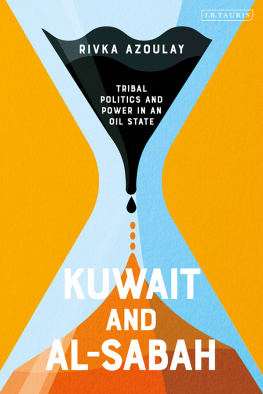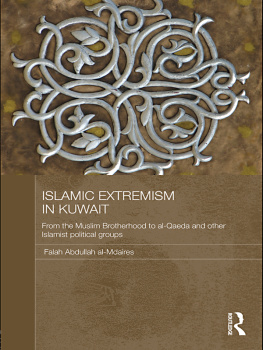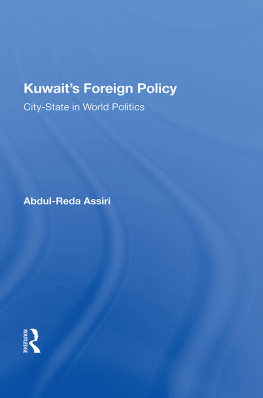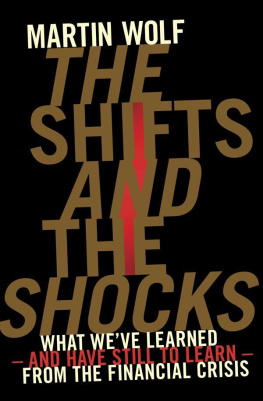Kuwait:
Fall and Rebirth
Mohammed A. Al-Yahya
First published in 1993 by
Kegan Paul International Ltd
This edition first published in 2009 by
Routledge
2 Park Square, Milton Park, Abingdon, Oxon, 0X14 4RN
Simultaneously published in the USA and Canada
by Routledge
270 Madison Avenue, New York, NY 10016
Routledge is an imprint of the Taylor & Francis Group, an informa business
Mohammed Abdulrahman Al-Yahya 1993
Printed and bound in Great Britain
All rights reserved. No part of this book may be reprinted or reproduced or utilised in any form or by any electronic, mechanical, or other means, now known or hereafter invented, including photocopying and recording, or in any information storage or retrieval system, without permission in writing from the publishers.
British Library Cataloguing in Publication Data
A catalogue record for this book is available from the British Library
ISBN 10: 0-7103-0463-3 (hbk)
ISBN 13: 978-0-7103-0463-6 (hbk)
Publishers Note
The publisher has gone to great lengths to ensure the quality of this reprint but points out that some imperfections in the original copies may be apparent. The publisher has made every effort to contact original copyright holders and would welcome correspondence from those they have been unable to trace.
Dedicated to our martyrs who died during the occupation of our country and in the war of liberation, and to our prisoners of war still remaining in captivity
CONTENTS
PREFACE
The recent history of the Kuwait economy has been inextricably bound up with the history of oil. Oil has been the main source of the nations wealth, but the health and vitality of the national economy depends firstly on how that wealth is utilised, and secondly on the way in which the national and private institutions combine to ensure the efficient regulation of national economic affairs. Kuwaits legal and governmental systems are based on principles which guarantee the freedom of the individual to pursue his or her economic advancement with the minimum state interference, and the national wealth is distributed in such a way as to facilitate this pursuit. Occasional aberrations are part of the price necessary to maintain this freedom, and the test of a nations maturity lies not in whether such aberrations occur, but how its regulatory authorities are able to control them and limit their effects.
During the past decade Kuwaits economic development has been affected by two severe shocks a collapse in an unofficial stock market in 1982, and the invasion in 1990 coupled with the subsequent war of liberation in the following year. These shocks occurred during a period in which other adverse economic and political events were impinging on the region: the falling price of oil and the Iran-Iraq war being the most prominent. How these shocks affected Kuwait, and especially its economic future, and how they were managed in order to limit their effects, form the common theme throughout this book which is written from the point of view of a banker with long experience in national economic affairs and who remained in Kuwait throughout the occupation.
Mohammed Abdulrahman Al-Yahya
DOLLAR-DINAR EXCHANGE RATE
During the years 19821992, the annual average exchange rate of the Kuwaiti dinar in US dollars was as follows:
1982 (1 dinar =) 3.473 dollars |
1983 | 3.431 |
1984 | 3.379 |
1985 | 3.324 |
1986 | 3.442 |
1987 | 3.586 |
1988 | 3.585 |
1989 | 3.404 |
1990 | 3.434 |
1991 | 3.458 |
1992 | 3.417 |
1
KUWAIT: A HISTORICAL PERSPECTIVE
Although there are some traces, and also a few hazy records, of earlier settlements in the region where modern Kuwait City now stands, the Kuwait we know had its beginnings during the later years of the eighteenth century, when a group of families moved out of the Najd, a region in the centre of the Arabian Peninsula, and settled in the area. Not that it could have been as completely desolate a spot as is often supposed. There were important trade routes crossing at or near what must have been the site of the first settlement, with camel trains from the north and east to Arabia and Africa intersecting at the head of the Gulf, and with much trade between Europe and the Indies and China crossing the Levant to and from the seaports on the Gulfs shore. It is thought, too, that trade between the area and the East Coast of Africa and other areas of the Indian Ocean was established quite early in Kuwaits modern history, but although more and more evidence of this and other matters is continually coming to light, little can be asserted with documentary precision. What is known, however, is that the original families which comprised the first settlement formed a closely knit community, and although they were joined by others during the following decades, that same close-knit community spirit has been a feature of Kuwaits development right up to the present day, with those same original families still forming the nucleus of much of the commercial, social and political life of the country.
During the years prior to the twentieth century it is evident that Kuwaits prosperity depended upon the sea. Very little agricultural land was available in the hinterland, and water was in very short supply, and although the early families from the Najd would have had a pastoral background, Kuwaitis soon became famous as seafarers, with their distinctive trading dhows (known as booms) being common in the ports right down the East African coast and on the coasts of India and beyond to the shores of the Malay Peninsula. The boom was probably the ultimate development of the dhow, being fast and versatile, yet able to withstand the rigorous journeys which such trade necessitated. A commercial network developed on the basis of this trade, and many of the great commercial families of Kuwait set up trading establishments in the numerous ports of call around the coasts of the Indian Ocean, and also invested in date plantations and other sources of trade goods, primarily in Iraq, to supply them with the materials on which their commercial activities depended.
In those days ocean-going ships depended entirely on the wind for motive power, and during certain times of the year long journeys were not possible. Kuwaiti seafarers soon found another activity to employ their ships during such periods, and this was nearer home: it was pearling. The pearls of the Gulf were famous, and in the middle of the nineteenth century up to 600 boats might be seen over the pearling grounds during the pearling season. Kuwaiti boats would have formed a prominent part of the fleet. Dealing in pearls became an important activity in Kuwait, as did dealing in gold, which was the life-blood of the trade in goods which their booms were carrying across the seas. Whether trading or pearling, however, the Kuwaiti mariners endured a hard life indeed. Pearl diving was dangerous in the extreme, and regularly took its toll of those who practised the occupation, either through fatal accidents or through a degeneration of health due to the adverse conditions under which they worked. At the same time, trading voyages on the open sea necessitated long weeks and months in sailing craft which offered little protection from the elements and in which the supplies of food and water were both basic and limited. Small wonder, then, that the Kuwaiti people developed an independence and resilience unsurpassed in the region, and that by the end of the nineteenth century their prowess in trade and commerce had become renowned.







